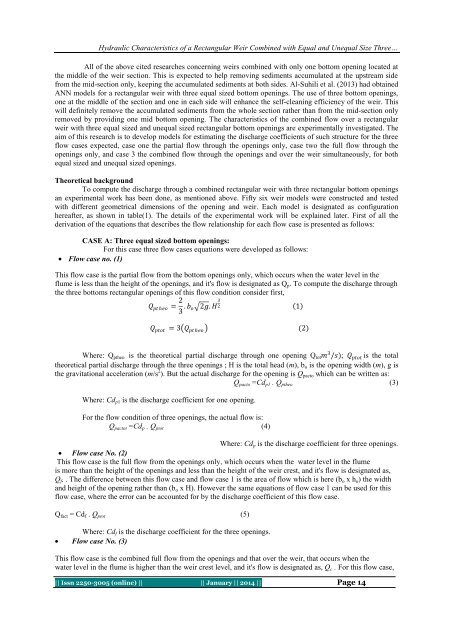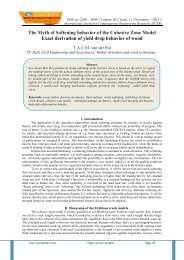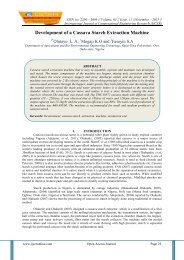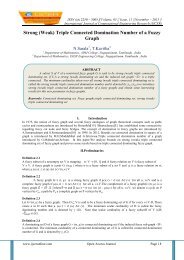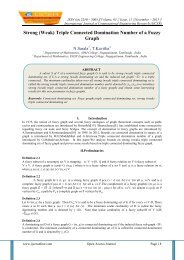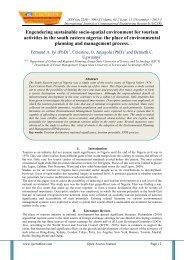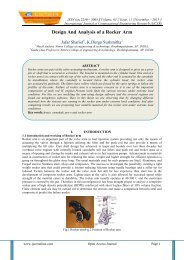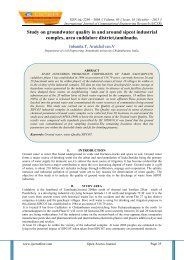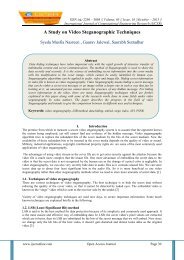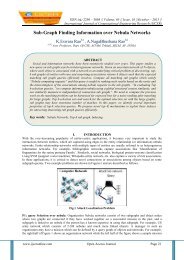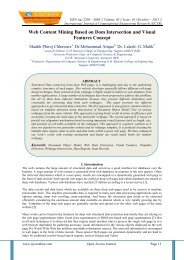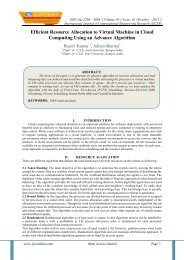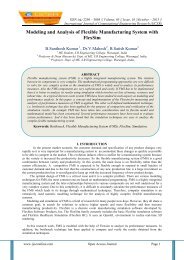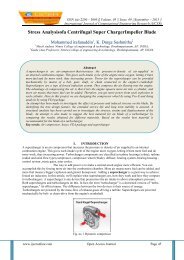C040101013029.pdf
International Journal of Computational Engineering Research(IJCER) is an intentional online Journal in English monthly publishing journal. This Journal publish original research work that contributes significantly to further the scientific knowledge in engineering and Technology.
International Journal of Computational Engineering Research(IJCER) is an intentional online Journal in English monthly publishing journal. This Journal publish original research work that contributes significantly to further the scientific knowledge in engineering and Technology.
You also want an ePaper? Increase the reach of your titles
YUMPU automatically turns print PDFs into web optimized ePapers that Google loves.
Hydraulic Characteristics of a Rectangular Weir Combined with Equal and Unequal Size Three…<br />
All of the above cited researches concerning weirs combined with only one bottom opening located at<br />
the middle of the weir section. This is expected to help removing sediments accumulated at the upstream side<br />
from the mid-section only, keeping the accumulated sediments at both sides. Al-Suhili et al. (2013) had obtained<br />
ANN models for a rectangular weir with three equal sized bottom openings. The use of three bottom openings,<br />
one at the middle of the section and one in each side will enhance the self-cleaning efficiency of the weir. This<br />
will definitely remove the accumulated sediments from the whole section rather than from the mid-section only<br />
removed by providing one mid bottom opening. The characteristics of the combined flow over a rectangular<br />
weir with three equal sized and unequal sized rectangular bottom openings are experimentally investigated. The<br />
aim of this research is to develop models for estimating the discharge coefficients of such structure for the three<br />
flow cases expected, case one the partial flow through the openings only, case two the full flow through the<br />
openings only, and case 3 the combined flow through the openings and over the weir simultaneously, for both<br />
equal sized and unequal sized openings.<br />
Theoretical background<br />
To compute the discharge through a combined rectangular weir with three rectangular bottom openings<br />
an experimental work has been done, as mentioned above. Fifty six weir models were constructed and tested<br />
with different geometrical dimensions of the opening and weir. Each model is designated as configuration<br />
hereafter, as shown in table(1). The details of the experimental work will be explained later. First of all the<br />
derivation of the equations that describes the flow relationship for each flow case is presented as follows:<br />
CASE A: Three equal sized bottom openings:<br />
For this case three flow cases equations were developed as follows:<br />
Flow case no. (1)<br />
This flow case is the partial flow from the bottom openings only, which occurs when the water level in the<br />
flume is less than the height of the openings, and it's flow is designated as Q p . To compute the discharge through<br />
the three bottoms rectangular openings of this flow condition consider first,<br />
Q pt eo = 2 3 . b o 2g. H 3 2 1<br />
Q ptot = 3 Q pt eo (2)<br />
Where: Q ptheo is the theoretical partial discharge through one opening Q totm 3 /s); Q ptot is the total<br />
theoretical partial discharge through the three openings ; H is the total head (m), b o is the opening width (m), g is<br />
the gravitational acceleration (m/s 2 ). But the actual discharge for the opening is Q pacto which can be written as:<br />
Q pacto =Cd p1 . Q ptheo (3)<br />
Where: Cd p1 is the discharge coefficient for one opening.<br />
For the flow condition of three openings, the actual flow is:<br />
Q pactot =Cd p . Q ptot (4)<br />
Where: Cd p is the discharge coefficient for three openings.<br />
Flow case No. (2)<br />
This flow case is the full flow from the openings only, which occurs when the water level in the flume<br />
is more than the height of the openings and less than the height of the weir crest, and it's flow is designated as,<br />
Q f , . The difference between this flow case and flow case 1 is the area of flow which is here (b o x h o ) the width<br />
and height of the opening rather than (b o x H). However the same equations of flow case 1 can be used for this<br />
flow case, where the error can be accounted for by the discharge coefficient of this flow case.<br />
Q fact = Cd f . Q ptot (5)<br />
Where: Cd f is the discharge coefficient for the three openings.<br />
Flow case No. (3)<br />
This flow case is the combined full flow from the openings and that over the weir, that occurs when the<br />
water level in the flume is higher than the weir crest level, and it's flow is designated as, Q c . For this flow case,<br />
|| Issn 2250-3005 (online) || || January || 2014 || Page 14


